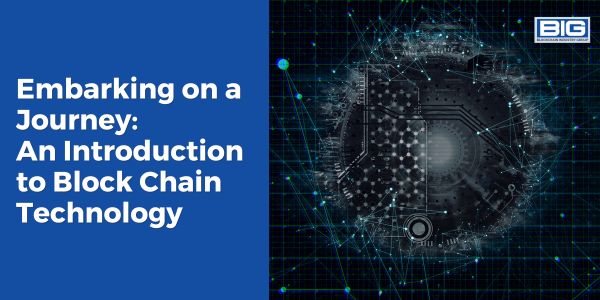
In the world of digital innovation, few technologies have garnered as much attention and promise as block chain. As a decentralized and transparent system, block chain has the potential to revolutionize industries, reshape processes, and empower individuals.
In this in-depth article, we will embark on a journey to explore the fundamentals of block chain technology, its key components, and its real-world applications. By providing a comprehensive introduction, we aim to demystify this groundbreaking technology and highlight its transformative capabilities.
Understanding the Basics: What is Block Chain?

At its core, block chain is a distributed ledger that records and verifies transactions in a transparent and immutable manner. Unlike traditional centralized systems, block chain operates on a network of computers, known as nodes, which collectively maintain and validate the integrity of the ledger. This decentralized structure ensures transparency, security, and resilience.
Key Components: Exploring the Building Blocks
To grasp the inner workings of block chain, it is crucial to understand its key components:
- Blocks: A block is a collection of data that contains a set of transactions. Each block is linked to the previous block through a cryptographic hash, forming a chain of interconnected blocks. This linking mechanism ensures the immutability and integrity of the recorded transactions.
- Decentralization: Block chain operates on a decentralized network of nodes, eliminating the need for a central authority. This distributed nature ensures that no single entity has control over the entire system, enhancing transparency and reducing the risk of manipulation.
- Cryptographic Hash Functions: Block chain employs cryptographic hash functions to convert data into a fixed-length alphanumeric string. This hashing process ensures the integrity of the data within each block and establishes the link between blocks. Any modification to the data within a block would result in a different hash, making it nearly impossible to tamper with the recorded information.
Consensus Mechanisms: Establishing Trust and Security
To maintain the integrity of the block chain and agree on the validity of transactions, various consensus mechanisms are employed:
- Proof of Work (PoW): Popularized by Bitcoin, PoW requires participants, known as miners, to solve complex mathematical puzzles to validate transactions and add new blocks to the chain. This energy-intensive algorithm ensures security but comes with high computational requirements.
- Proof of Stake (PoS): In contrast to PoW, PoS selects validators based on the number of coins they hold. Validators are chosen to validate transactions and create new blocks, reducing the energy consumption associated with PoW.
- Delegated Proof of Stake (DPoS): DPoS introduces a voting system where stakeholders elect a set of trusted nodes called delegates. These delegates are responsible for validating transactions and producing new blocks. DPoS enhances scalability and reduces computational requirements.
Real-World Applications: Unleashing the Potential
Block chain technology has the potential to disrupt and transform various industries. Here are some notable examples of its real-world applications:
- Supply Chain Management: Block chain provides end-to-end visibility and traceability in supply chains, enabling transparent tracking of goods from production to delivery. This ensures accountability, reduces fraud, and enhances efficiency.
- Financial Services: The financial sector has witnessed significant disruption through block chain applications such as cryptocurrencies, smart contracts, and decentralized finance (DeFi). These innovations streamline processes, eliminate intermediaries, and enhance security.
- Healthcare: Block chain holds immense potential in healthcare for secure storage and sharing of patient records, tracking pharmaceutical supply chains, and enabling precise and transparent clinical trials.
- Voting Systems: Block chain offers secure and tamper-resistant voting systems that enhance transparency, prevent fraud, and enable remote participation.
Challenges and Future Outlook: Navigating the Path Ahead
While block chain technology holds immense promise, it also faces certain challenges on its path to widespread adoption. Some of the key challenges include:
- Scalability: As block chains grow in size and usage, scalability becomes a significant concern. The need to process a high volume of transactions quickly while maintaining decentralization is an ongoing area of research and development.
- Interoperability: Interoperability among different block chain platforms and networks remains a challenge. Seamless integration and communication between disparate block chains are vital for the widespread adoption and efficiency of the technology.
- Regulatory Frameworks: The evolving regulatory landscape poses challenges and uncertainties for block chain adoption. Striking a balance between innovation and ensuring compliance with existing regulations is crucial for the technology’s growth.
- Energy Consumption: Certain consensus mechanisms, such as PoW, require significant computational power and energy consumption. Addressing the environmental impact of block chain technology is a pressing concern that requires sustainable solutions.
Unveiling the Power: Key Features and Benefits of Block Chain
—
Unlocking the Potential: Understanding How Block Chain Works
—
Harnessing Innovation: 5 Benefits of Block Chain Technology
—
Decoding the Distinction: Block Chain vs. Bitcoin
Despite these challenges, the future outlook for block chain technology remains highly promising. As the technology continues to mature and evolve, advancements in scalability solutions, standardization efforts, and regulatory frameworks are expected to drive its adoption across various industries.
Block chain technology represents a revolutionary approach to transparency, security, and decentralized transactions. Its potential applications span a wide range of industries, from supply chain management to finance, healthcare, and voting systems. By understanding the basics, exploring the key components, and examining real-world applications, we can grasp the transformative capabilities of block chain technology and navigate the exciting journey ahead.
Note: In this blog, we opted for the term “Block Chain” instead of “Blockchain” to cater to newcomers in the blockchain space, ensuring the content is more accessible for those readers.



